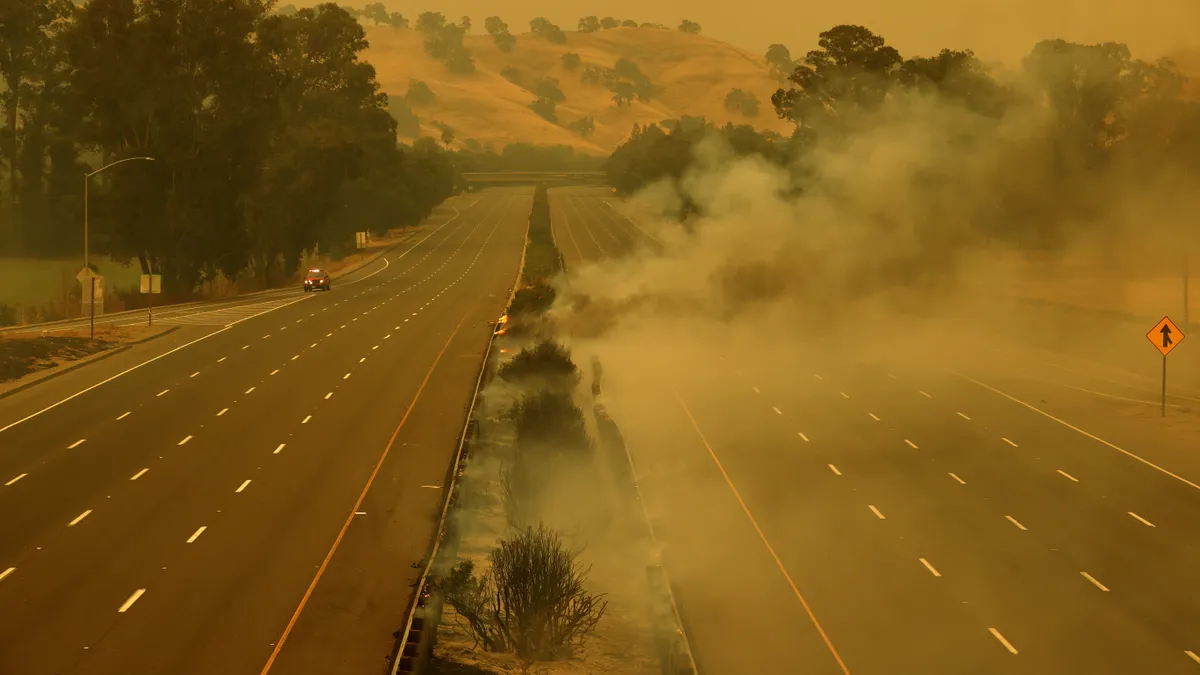Dive Brief:
- California's Office of Energy Infrastructure Safety awarded the state's utilities wildfire-related safety certifications for 2020 despite "serious deficiencies" in their fire mitigation plans, according to a report from the state's auditor.
-
The office "approved plans despite some utilities' failure to demonstrate that they are appropriately prioritizing their mitigation activities, and subsequent reviews have found that some utilities failed to focus their efforts in high fire-threat areas," acting California State Auditor Michael Tilden told Gov. Gavin Newsom, D, and legislative leaders in a letter Thursday.
- While expressing appreciation for the auditor's input, "We stand behind the comprehensive and extensive evaluation of the wildfire mitigation plans conducted by our team of more than 25 engineers, scientists, firefighters, and utility experts," Office of Energy Infrastructure Safety Director Caroline Thomas Jacobs said in a statement.
Dive Insight:
Wildfires caused by damaged power lines have posed serious financial liabilities to California utilities in recent years, pushing Pacific Gas & Electric Co. to declare bankruptcy in early 2019. Utilities have been moving to address this threat by implementing fire prevention strategies in their service areas — from strengthening equipment to, in some cases, shutting off the power when weather conditions increase the risk of fires. The OEIS — part of the state's Natural Resources Agency — is responsible for approving the wildfire mitigation plans that utilities put together every year.
The office is also tasked with issuing safety certifications to utilities. In 2019, California lawmakers created a wildfire insurance fund for the state's investor-owned utilities, through which they could be reimbursed for damages they pay to victims of fires their equipment caused. If a utility has a safety certification for the period in which the fire occurred, it is presumed to have acted "reasonably" — unless demonstrated otherwise — meaning it might not have to repay the fund in the future.
The state auditor's report found that the office's process for approving utility wildfire plans doesn't ensure that improvements are being made in areas that are especially prone to wildfires. The energy safety office also issued 2020 safety certifications to the state's three largest utilities — PG&E, Southern California Edison and San Diego Gas & Electric Co. — despite identifying "serious deficiencies" in each of their plans, the report found. As an example, the office concluded that all three utilities failed to demonstrate in their 2020 plans how they would use risk modeling in their decision-making to target the parts of the grid especially prone to fire risk.
This practice was corrected the following year, and the office did not approve subsequent plans until the utilities addressed these critical issues. However, "we question the appropriateness of the process it followed to approve mitigation plans and issue the 2020 safety certifications," the report noted.
The report also provided a series of recommendations for the state to improve the review process. For instance, it urged the California legislature to require that the energy safety office conclude that the utility has "substantially" implemented its wildfire prevention plan before issuing it a safety certification. It also recommended that the office not greenlight utilities' plans until the utilities identify how they plan to prioritize their fire prevention work.
Wildfire-related public safety power shut-offs (PSPS) create hardships for utility customers, which is why Southern California Edison has focused its efforts on reducing the outages and helping affected customers, according to utility spokesperson Reggie Kumar.
"PSPS will remain a measure of last resort to reduce the risk of a significant wildfire to protect our customers, communities and employees in high fire risk areas," Kumar said.
PG&E is currently reviewing the state auditor's report and is "committed to working with our external partners on solutions that will make additional progress toward our shared aim of safety focused on stopping catastrophic wildfires and meeting our state's climate challenges," utility spokesperson Lynsey Paulo said in an emailed statement.
The utility has completed its goal of installing more than 1,300 weather stations — one on every 20 miles of power lines — in high fire risk areas, and in 2021, it installed 153 high-definition wildfire cameras, bringing it closer to a goal of 600 cameras by 2022, she added.















